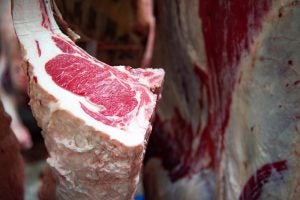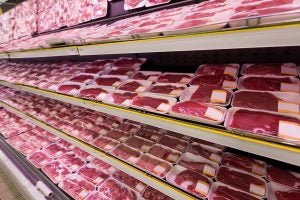The past year witnessed the smallest beef cow inventory in half a century. Coupled with robust demand, this resulted in record-high average prices for fed cattle and calves in 2023.
According to the CattleFax Outlook Seminar, held as part of the 2024 Cattle Industry Convention and NCBA Trade Show in Orlando, Florida, there will almost certainly be new record average prices for all of 2024.
And that trend will likely continue as reduced cattle numbers and beef production continue over the next three years, leverage and profitability will favor cattle producers.
Despite record prices, the expansion will likely be delayed once again. Lingering drought, high input costs, limited labor availability, high-interest rates, and market uncertainty all serve as headwinds against growing the cowherd. The current cattle cycle anticipates slower and more prolonged expansion, with heifer retention causing a supply decline with expected lows in fed slaughter by 2026. Higher cattle prices and reduced feeding costs will continue to improve margins for cow-calf producers for the next several years, a much-needed improvement to drive expansion as weather patterns allow, according to CattleFax.

After several months of watching El Niño’s influence on the global weather pattern, Meteorologist Matt Makens said the El Niño event that placed moisture on the South and Southeast is fading away, and La Niña is showing signs of making a rapid return.
“During the next several weeks, we will continue to see strong and wet storm systems move across the central and southern states. Increased odds for snow and cold as far south as Texas will mean possible impacts on calving and wheat,” he said. “Take this moisture now and make the most of it; look for a good start to this grazing season overall, but be mindful that drought conditions will increase for the Southern Plains during summer and fall as we see our pattern change quickly.”
As La Niña’s influence grows, increased heat and drought-related issues are expected for the Central and Southern Plains. The moisture pattern will favor the northern tier of states and the Ohio to Tennessee Valleys.
Kevin Good, vice president of market analysis at CattleFax, reported that the U.S. beef cow herd declined 2 percent, with inventories at 28.2 million head at the beginning of this year.
“Though drought conditions did improve in many regions, over a third of the cow herd was affected by drought in 2023, causing limited heifer retention and more liquidation in some regions. This will limit growth to the cow herd in the near term,” Good said.
Cattle slaughter by the numbers
Cow and bull slaughter is forecast to be 6.5 million head in 2024, down around 800,000 head from 2023. CattleFax predicted feeder cattle and calf supplies outside of feed yards would be 1 million head smaller than in 2023 at 24.1 million head.
Commercial fed slaughter in 2024 is forecast to decline by 750,000 to 24.8 million head. Cattle on feed inventories began 2024 up about 2 percent at 11.9 million head. Good noted, “Though inventories may remain somewhat elevated for a few months, they are expected to decline significantly through the second half of the year.”
After about a 1.3-billion-pound decline in 2023, beef production is expected to be down another billion pounds in 2024 to total about 25.9 billion pounds. The decline in production in 2024 will lead to a 1.7-pound decline in net beef supply to 56 pounds per person.

Here’s what cattle prices are forecast to look like in 2024:
- Fed steers – finished animals ready for harvest will average $184/cwt, up $9 from 2023.
- Feeder steers (800 pounds) – animals ready to go into a feedlot for final finishing will average $240/cwt, up $20 from last year.
- Steer calves (550 pounds) – recently weaned calves, usually headed for a stocker grazing operation before they head to the feedlot, will average $290/cwt, up $28 from last year.
- Utility cows – culls that usually go for hamburger meat will average $115/cwt, up $16 from last year.
“When thinking about what demand looks like, we need to think about what our consumer looks like with the U.S. economy being the driving factor going into 2024,” Good said. “Though inflation has moderated, consumer debt and interest rates, cheaper alternative proteins, and economic uncertainty may limit spending and impact purchasing decisions.”
Beef prices and demand will stay high
People still love their beef, and premium prices haven’t slowed that demand. Retail Beef prices are expected to average $7.90/pound, and while higher beef prices may soften consumer purchasing habits, Good predicted the consumer preference for the quality, consistency, and safety of U.S. beef would continue to support relatively strong demand. “Premiums for higher quality beef should remain as consumers have shown a willingness to pay for Choice grade or better beef.”
Global protein demand has continued to rise worldwide, and tighter global protein supplies should broadly support prices in 2024. U.S. beef exports saw large declines in 2023, down about 13 percent, and another 5 percent decline is expected in 2024, driven by smaller U.S. production and higher prices. Japan and South Korea remain the top beef export destinations in the U.S.

Murphy says that now’s the time to expand
Randy Blach, CattleFax’s chief executive officer, concluded the session with an overall positive outlook and noted that the current cattle cycle will be much slower compared to the last as heifer retention has not started nationwide.
Bred heifers are currently selling for about $2,400. It will take two years to raise a replacement heifer and get a calf out of her. However, he expects the peak in cattle prices to occur in 2025-2026. If that cow stays productive for five to six years, that’s a $1,000 bargain over her lifetime.
In the meantime, industry profitability will continue to swing in favor of the cow-calf producer as excess feeding and packing capacity chases a declining supply of feeder cattle and calves.


